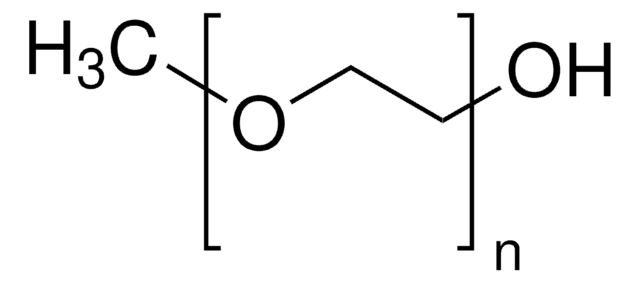84797
Poly(éthylène glycol)
BioUltra, 2,000
Synonyme(s) :
PEG
About This Item
Produits recommandés
Niveau de qualité
Gamme de produits
BioUltra
Forme
powder
Poids mol.
Mr 1900-2200
Impuretés
insoluble matter:, passes filter test
≤0.001% peroxides (as H2O2):
pH
5.5-7.0 (25 °C, 50 mg/mL in H2O)
Pf
50-53 °C
Solubilité
H2O: 50 mg/mL at 25 °C, clear, colorless
Traces d'anions
chloride (Cl-): ≤50 mg/kg
sulfate (SO42-): ≤50 mg/kg
Traces de cations
Al: ≤5 mg/kg
As: ≤0.1 mg/kg
Ba: ≤5 mg/kg
Bi: ≤5 mg/kg
Ca: ≤10 mg/kg
Cd: ≤5 mg/kg
Co: ≤5 mg/kg
Cr: ≤5 mg/kg
Cu: ≤5 mg/kg
Fe: ≤5 mg/kg
K: ≤200 mg/kg
Li: ≤5 mg/kg
Mg: ≤5 mg/kg
Mn: ≤5 mg/kg
Mo: ≤5 mg/kg
Na: ≤200 mg/kg
Ni: ≤5 mg/kg
Pb: ≤5 mg/kg
Sr: ≤5 mg/kg
Zn: ≤5 mg/kg
λ
50 mg/mL in H2O
Absorption UV
λ: 260 nm Amax: ≤0.1
λ: 280 nm Amax: ≤0.04
Chaîne SMILES
C(CO)O
InChI
1S/C2H6O2/c3-1-2-4/h3-4H,1-2H2
Clé InChI
LYCAIKOWRPUZTN-UHFFFAOYSA-N
Vous recherchez des produits similaires ? Visite Guide de comparaison des produits
Description générale
Application
- as a constituent in the preparation of liquid desiccant solutions
- as a precipitating agent and additive in protein crystallization
- as a representative biocompatible polymer to decipher its interactions with cellular system at molecular level
Code de la classe de stockage
11 - Combustible Solids
Classe de danger pour l'eau (WGK)
WGK 1
Point d'éclair (°F)
281.5 °F - closed cup
Point d'éclair (°C)
138.6 °C - closed cup
Équipement de protection individuelle
Eyeshields, Gloves, type N95 (US)
Faites votre choix parmi les versions les plus récentes :
Déjà en possession de ce produit ?
Retrouvez la documentation relative aux produits que vous avez récemment achetés dans la Bibliothèque de documents.
Les clients ont également consulté
Notre équipe de scientifiques dispose d'une expérience dans tous les secteurs de la recherche, notamment en sciences de la vie, science des matériaux, synthèse chimique, chromatographie, analyse et dans de nombreux autres domaines..
Contacter notre Service technique
